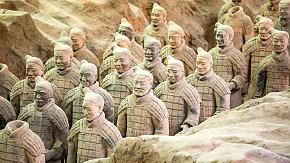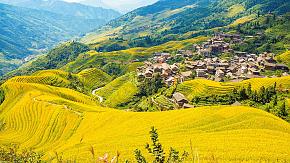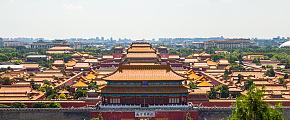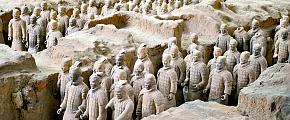Another Sample of the Special Food of Xi'an, China
Beside the lamb (or beef) and bread soup, 泡馍 paomo; the "Chinese hamburger", 肉夹馍 rou jia mo; and biangbiang noodles, there are still lots of special food in Xi'an that you may haven't heard about them.
This time I want to introduce some more dishes and hopefully tempt you to visit Xi'an for a try. Most of these dishes are simple street favorites, also sold in the many small restaurants all over the city, but most famously in the Muslim Quarter.
Liangpi
Liangpi (凉皮 - liáng pí ), literally means "cold skin", which doesn't sound very appealing. However, it is much more delicious than it may sound. In fact, liangpi is a special type of noodle which originated in Shaanxi Province, of which Xi'an is the capital. The noodles are made from wheat or rice flour, which is mixed with water and salt to form a basic dough. This dough is then repeatedly rinsed in more water until all the starch is washed out. The remaining dough is then reserved for another use and the starch filled rinsing water allowed to rest, usually overnight. After resting, the starch settles to the bottom of the container into a sort of starch paste and the clearer water on top is drained off. The starch paste is then spread into a thin layer (the skin) and steamed until set. Then, when cool, it is sliced into relatively thick noodles, ready to be served.
 Liangpi
Liangpi
Liangpi is served cold, even in the icy midwinter, and is nearly always vegan. The noodles are mixed with bean sprouts, julienned cucumber, carrot or daikon radish, peanuts and is dressed with a spicy chili sauce. It often also contains fried wheat gluten or seitan, which is made from the reserved wheat dough after the starch has been removed for the noodles. This is used as a popular meat substitute in East Asia. Not for the gluten intolerant, obviously.
Tiger Salad
Tiger salad (老虎菜 - lǎo hǔ cài) is one of the few dishes served raw in China, In fact, there are two versions of this salad. One is from the far north-east of China but the version found in Xi'an originated in China's westernmost province of Xinjiang, China's most Muslim province which lies on the ancient Silk Road which starts or ends in Xi'an depending which direction you are going in. It consists of a mix of julienned strips of cucumber, carrot, daikon, onion, coriander leaf/cilantro, etc, then tossed in a spicy chilli dressing. The strips of vegetable are thought to resemble the stripes of the tiger, hence the name. I often have this with my rou jia mo, when I'm in Xi'an. The refreshing, crisp salad perfectly complements the sandwich.
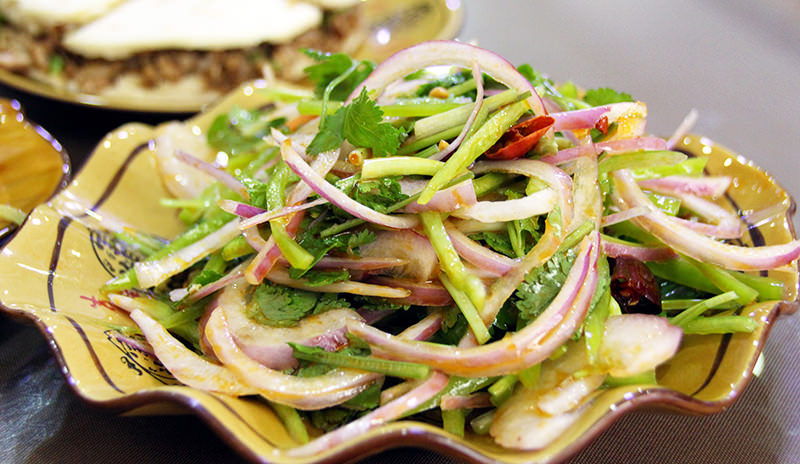 Tiger Salad (with a rou jia mo lurking in the background)
Tiger Salad (with a rou jia mo lurking in the background)
Dapanji
Dapanji (大盘鸡 - dà pán jī ) is another dish from Xinjiang which is very popular in Xi'an. Literally, dapanji means "Big Plate Chicken" and that describes it perfectly. Believed by some to have been invented by a Sichuanese immigrant to the area it is chicken with potatoes and green peppers in a spicy sauce containing garlic, ginger, cumin, star anise and Sichuan peppercorns. It is served with hand pulled noodles to soak up the delicious sauce. Another, less common, version is served with naan bread instead of the noodles.
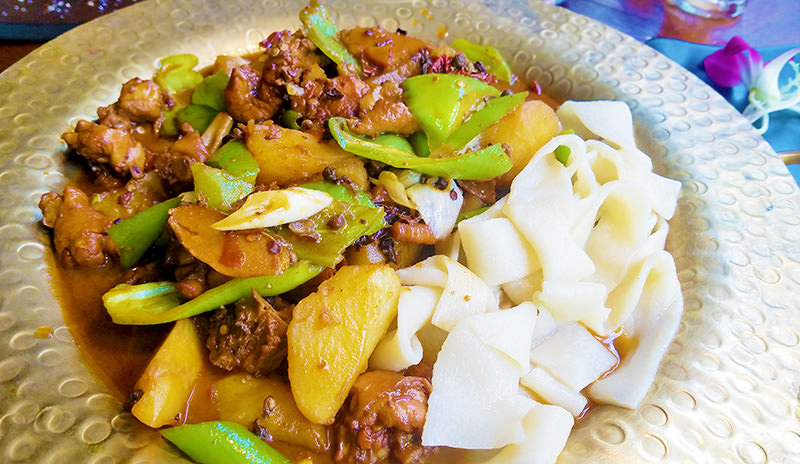 Dapanji
Dapanji
Be careful not to over-order. Many restaurants will offer this in both small and large versions and I've seen people say they are very hungry and order the large one, only to be unable to finish most of it. It is a very filling dish and the small version can easily feed three or more people, especially when served alongside other dishes.
Steamed Beef and Wheat Powder
Steamed beef and wheat powder (粉蒸肉 - fěn zhēng ròu) is found in many parts of China, but Xi'an has its own unique version. Elsewhere, the dish is marinated pork belly with powdered rice which is steamed until tender. It is mainly a festive dish and popular at New Year. But in Xi'an, as many people don't eat pork, their version is made with beef and powdered wheat is usually used for the coating instead. If made by the traditional method, the marinade includes over 20 different herbs and spices and the whole production process can take up to ten hours or more. The dish is sold all over the Muslim Quarter.
Mutton Kebabs
Mutton Kebabs (羊肉串 - yáng ròu chuàn). Who doesn't like food on sticks? When I lived in Xi'an there was nothing I liked better of an evening than to go out, either alone or with friends and find a street stall selling Yang Rou Chuan. They weren't hard to find. These kebabs (see the last Chinese character in the name which looks like a kebab!) are sold all over China, but originated here in the west. They are available in some restaurants, but are more commonly found as street food. Mutton is threaded on sticks and grilled over charcoal while being sprinkled with cumin and chilli. They will omit the chili if you are not a spice lover. Me, I ask for extra! It is astonishing how many of these you can get through on a warm summer evening in the open air, washing them down with a cold beer in good company.
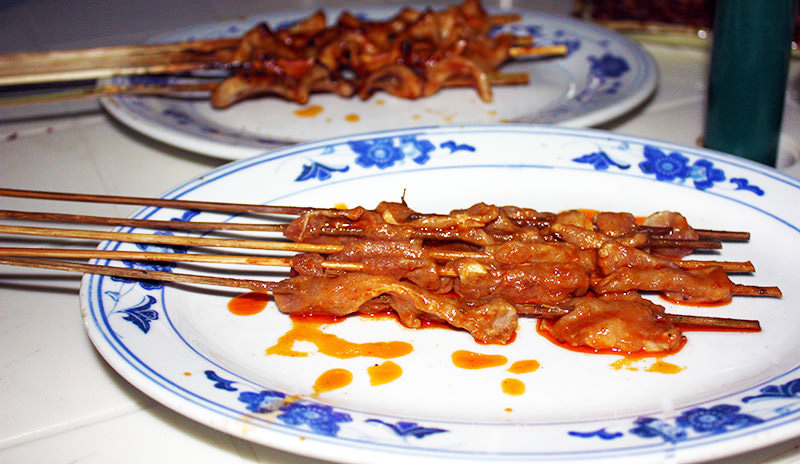 Mutton Kebabs
Mutton Kebabs
Some stalls sell only these; others also offer alternative meats such as beef or chicken and also sheep offal. Outside any of Xi'an's universities is a good place to look for kebab stalls and they are often cheaper than in the Muslim Quarter. I regularly ate them for a year at the same stall beside Northwest University near the South Gate of the wall. Cheap and cheerful.
Mince Noodles
Mince Noodles (臊子面 - sāo zi miàn) are another popular dish which originated in Shaanxi and can be found all over Xi'an, but not in the Muslim restaurants. It is said the best come from Qishan County which lies to Xi'an's west. The Chinese name does not translate well into English and is rather off-putting but it is a delicious dish of minced fatty pork in a strongly flavored stock with vinegar and chili powder. Also included can be carrots, tofu, green beans, day lily, eggs, wood-ear fungus, etc. A great winter warmer - sour, spicy and fragrant.
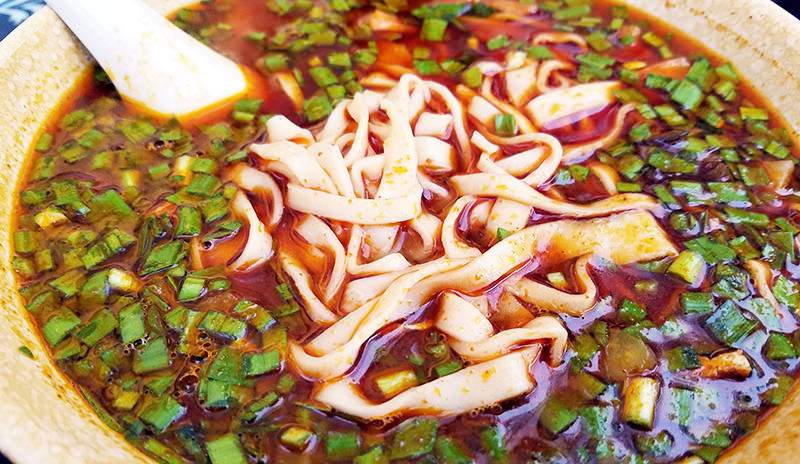 Mince Noodles
Mince Noodles
Rice and Jujube Cake
Rice and jujube cake (甑糕 - zèng gāo). When I mention "cake", you are probably immediately thinking "dessert". You'd be wrong. Zeng gao is nearly always eaten for breakfast. It is made from glutinous rice which is mixed with Chinese dates (jujubes) and kidney beans and steamed in an ancient type of steamer known as a "Zeng". These pots are known to have existed as early as 1600 BC. The cakes are much fresher. They are sweet and fruity without being too sugary. Most vendors only make one batch per day and when it's gone, it's gone. One elderly man used to sell it in the Muslim Quarter from the back of his bicycle, but you had to get there early as he'd be sold out by 8 o'clock - I'd be surprised if he is still alive.
Pomegranate Juice
Pomegranate juice (石榴汁 - shí liú zhī ). You are probably thirsty after all this and, depending on when you time your visit, Xi'an has the perfect thing to wet your whistle. When the autumnal season arrives, freshly squeezed pomegranate juice is sold on almost every street corner and makes a perfect accompaniment to those kebabs, if you are not in the mood for beer.
Another classic combination meal with a drink, sometimes called the golden triangle of Xi'an cuisine, is to have rou jia mo and liangpi with Ice Peak (冰峰 - bīng fēng ), an orange flavored soda.
Sweet and Sour Dumplings in Soup
Sweet and sour dumplings in soup (酸汤水饺 - suān tāng shuǐ jiǎo). Most people associate jiaozi dumplings with northeast China, but they are available all over and Xi'an has its own version, too. Here, they use mutton in the filling and the soup is made from a mutton broth flavored with leek, coriander leaf/cilantro and sesame seeds. Quite different from the version found elsewhere. They also have their own version of the Shanghai classic, Soup Dumplings (汤包 - tāng bāo), where the soup is in the dumplings and not the other way round. The locals swear the Xi'an version of the dumplings is much better!
I hope this has tickled your imaginary palate enough for you to consider visiting to try all these dishes and more for yourself. If none of them take your fancy, do not despair. Xi'an has restaurants covering all sorts of foods besides its own, including international cuisines such as Japanese, Italian, Spanish, American and Indian among others, besides other regions of China. You won't go hungry, but I do advise you to try some of Xi'an's specialties.
I'm hungry now! So, I'll finish here, but please don't forget that Odynovo can help you to organize a custom-designed tour to China, including Xi'an or anywhere else from our list of over 70 great destinations worldwide. Just tell us where and what you want and one of our travel experts will be back to you within 24 hours with a free suggested itinerary, which can be adapted to your precise requirements.
Related Posts You May Like
What Our Clients Say
Explore the latest verified reviews of Odynovo's travel services on Tripadvisor, Google, Trustpilot, Product Review and more trusted platforms.

